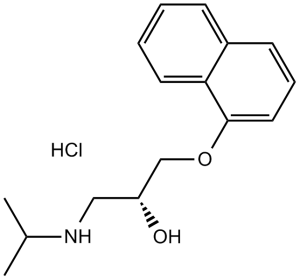Propranolol HCl (AY64043, ICI45520, NCS91523)
This product is for research use only, not for human use. We do not sell to patients.

For small sizes, please check our retail website as below: www.invivochem.com
| Size | Price | Stock |
|---|---|---|
| 25g | $550 | Check With Us |
| 50g | $850 | Check With Us |
| 100g | $1275 | Check With Us |
Cat #: V1152 CAS #: 318-98-9 Purity ≥ 98%
Description: Propranolol HCl (formerly ICI-45520, NCS-91523; AY-64043; Inderal among others), the hydrochloride salt of Propranolol, is a competitive and non-selective inhibitor of beta-adrenergic receptors with antihypertensive effects.
Top Publications Citing Invivochem Products
Publications Citing InvivoChem Products
Product Promise

- Physicochemical and Storage Information
- Protocol
- Related Biological Data
- Stock Solution Preparation
- Quality Control Documentation
| Molecular Weight (MW) | 295.8 |
|---|---|
| Molecular Formula | C16H21NO2.HCl |
| CAS No. | 318-98-9 |
| Storage | -20℃ for 3 years in powder formr |
| -80℃ for 2 years in solvent | |
| Solubility In Vitro | DMSO: 59 mg/mL (199.5 mM)r |
| Water: 6 mg/mL (20.3 mM)r | |
| Ethanol: <1 mg/mL | |
| Synonyms | AY-64043, ICI-45520, NCS-91523; AY 64043, ICI 45520, NCS 91523; AY64043, ICI45520, NCS91523; |
| Protocol | In Vitro | Propranolol hydrochloride (10-7 M-10-3 M; 24 and 48 hours) increases the total ERK1/2 levels in a dose-dependent manner, and ERK1/2 activation is observed specifically at 10-5 M in HemSCs |
|---|---|---|
| In Vivo | Propranolol hydrochloride (orally administration; 40 mg/kg; daily) significantly reduces the vessel diameter relative to the vehicle-treated implants, and increases the number of cells that expressed phosphorylated ERK1/2 within the IH Matrigel implant | |
| Animal model | A xenograft mouse model of IH (infantile hemangiomas) with HemSC cells | |
| Dosages | 40 mg/kg | |
| Administration | Orally administration; 40 mg/kg; daily |
These protocols are for reference only. InvivoChem does not
independently validate these methods.
| Solvent volume to be added | Mass (the weight of a compound) | |||
|---|---|---|---|---|
| Mother liquor concentration | 1mg | 5mg | 10mg | 20mg |
| 1mM | 3.3807 mL | 16.9033 mL | 33.8066 mL | 67.6133 mL |
| 5mM | 0.6761 mL | 3.3807 mL | 6.7613 mL | 13.5227 mL |
| 10mM | 0.3381 mL | 1.6903 mL | 3.3807 mL | 6.7613 mL |
| 20mM | 0.1690 mL | 0.8452 mL | 1.6903 mL | 3.3807 mL |
The molarity calculator equation
Mass(g) = Concentration(mol/L) × Volume(L) × Molecular Weight(g/mol)
Mass
=
Concentration
×
Volume
×
Molecular Weight*
The dilution calculator equation
Concentration(start)
×
Volume(start)
=
Concentration(final)
×
Volume(final)
This equation is commonly abbreviated as: C1 V1 = C2 V2
Concentration(start)
C1
×
Volume(start)
V1
=
Concentration(final)
C2
×
Volume(final)
V2
Step One: Enter information below
Dosage mg/kg
Average weight of animals g
Dosing volume per animal µL
Number of animals
Step Two: Enter the in vivo formulation
%DMSO
+
%
+
%Tween 80
+
%ddH2O
Calculation Results:
Working concentration:
mg/ml;
Method for preparing DMSO master liquid:
mg
drug pre-dissolved in
µL
DMSO(Master liquid concentration
mg/mL)
,Please contact us first if the concentration exceeds the DMSO solubility of the batch of drug.
Method for preparing in vivo formulation:
Take
µL
DMSO master liquid, next add
µL
PEG300, mix and clarify, next add
µL
Tween 80,mix and clarify, next add
µL
ddH2O,mix and clarify.
Note:
- (1) Please be sure that the solution is clear before the addition of next solvent. Dissolution methods like vortex, ultrasound or warming and heat may be used to aid dissolving.
- (2) Be sure to add the solvent(s) in order.




































